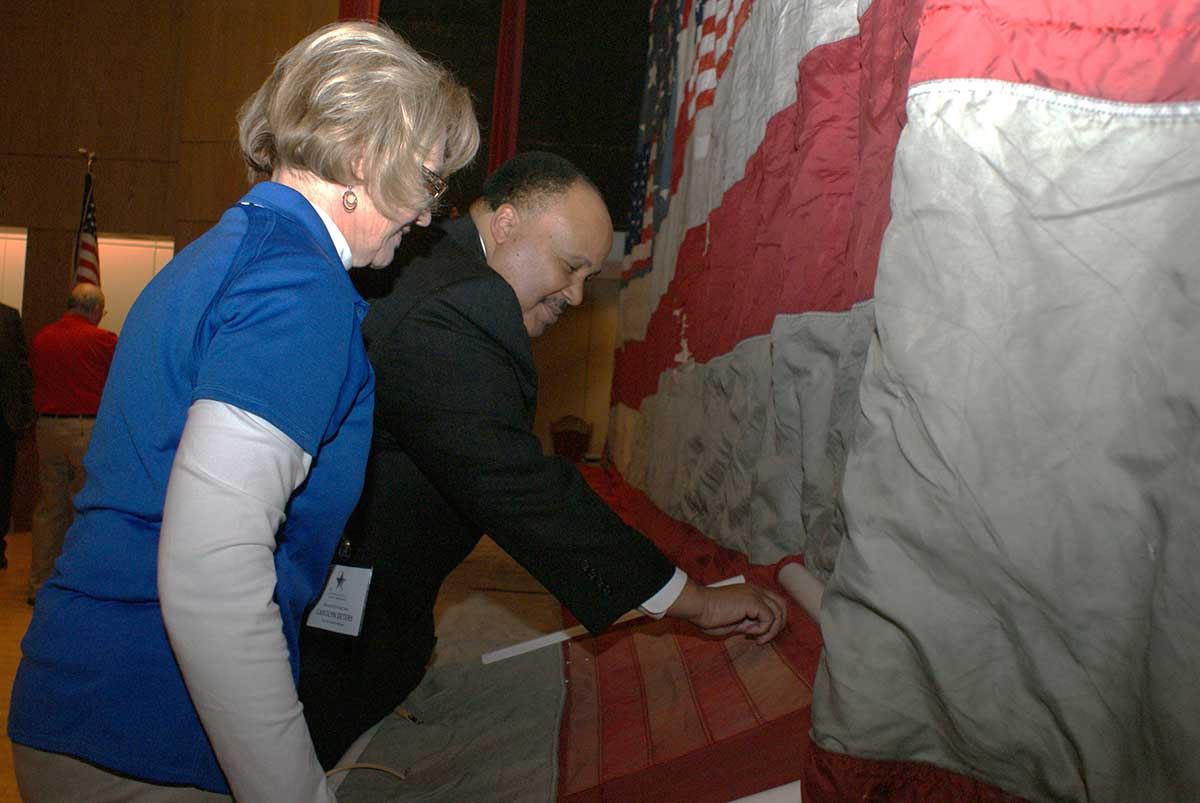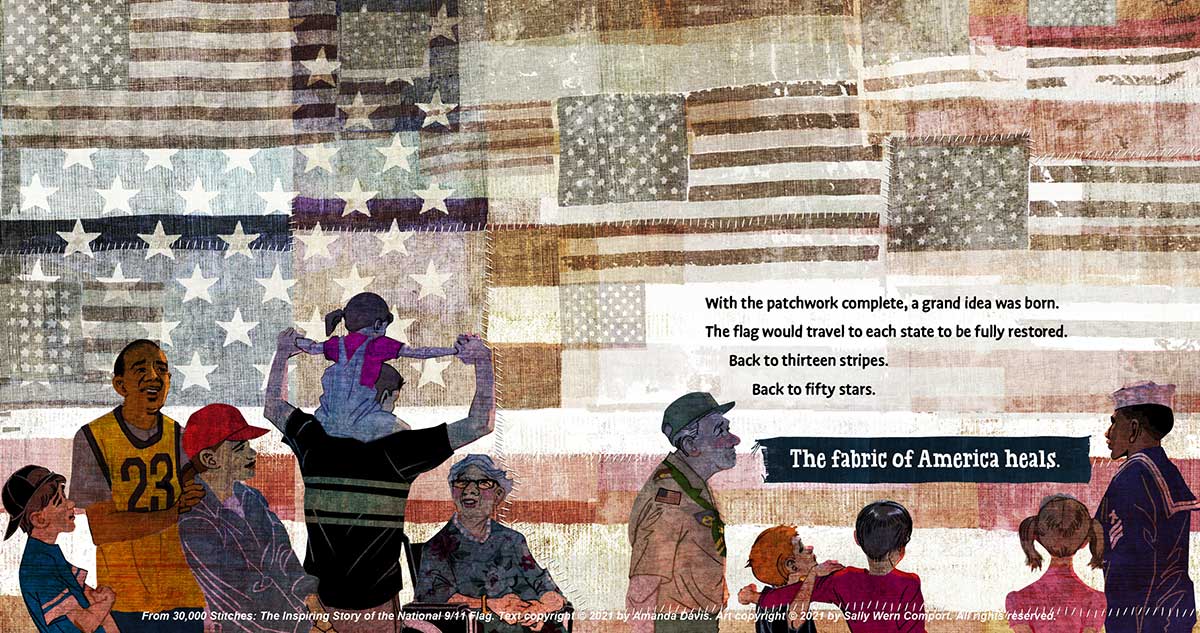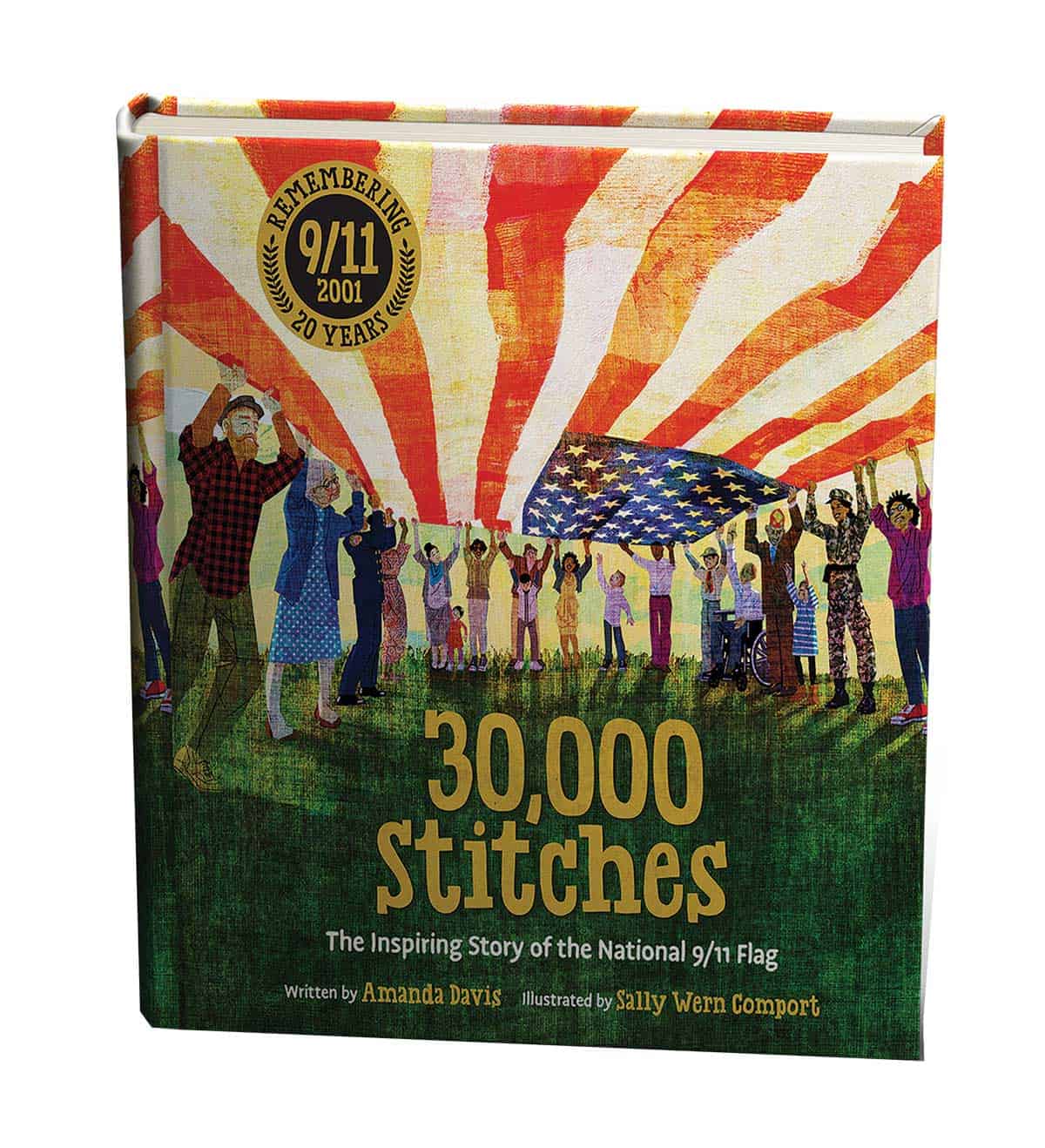Local author and art educator Amanda Davis discusses her debut nonfiction children’s book.
By Maria Allen
This year marks the 20th anniversary of the September 11, 2001 terrorist attacks and offers an opportunity to remember and honor the lives lost that day as well as the courage of the first responders. For Weymouth resident Amanda Davis, the anniversary is also a teachable moment. An art teacher at Hull High School, Davis recently published her first nonfiction picture book, “30,000 Stitches: The Inspiring Story of the National 9/11 Flag” (Hachette Book Group/WorthyKids, May 2021). Illustrated by Sally Wern Comport and penned by Davis, the book tells the true story of the American flag that flew over Ground Zero in the days after September 11th, 2001. Afterward, the torn and tattered flag traveled to all 50 states and was slowly stitched back together before returning to New York City to serve as a symbol of solidarity and hope. The book weaves together themes of healing and unity in a way that audiences of all ages can understand and enjoy.
We sat down with Amanda Davis to chat about the inspiration behind her new book and her desire to inform and inspire younger generations.
The book “30,000 Stitches: The Inspiring Story of the National 9/11 Flag” tells the true story of the American flag that flew over Ground Zero in the days after September 11th.

Q+A With Author Amanda Davis
How did you first come to learn the inspiring story of the National 9/11 Flag?
I first learned about the flag back in 2011. I strive to teach about the events of 9/11 each year and as the 10th remembrance was approaching, I was searching for a lesson I could do with my students. I came across a blurb about a torn and tattered American flag that flew over Ground Zero in the days after 9/11. That year, students learned about the flag and reflected on what it means to be an American (to them) and the unique aspects of their identities. The students then visually conveyed and unified these elements by crafting our own patchwork flag. It was a powerful and memorable project for the students and myself. I’ve always known that art and writing have the power to make difficult/essential topics more accessible but this lesson was a wonderful reminder.
What made you decide to write this book?
After visiting the National September 11 Memorial & Museum in 2014, and being overcome with emotion at the artifacts and the stories, I was reminded of the importance of telling the story of the flag. I decided to try my hand at crafting a manuscript for it. I have a background in journalism, so it was a delight getting to research and interview primary sources for the story. From the Ground Zero superintendent to flag tour staff, all of the people I spoke to about the flag were incredible.
Why did you choose to make it a picture book?
I wrote the story for children because I saw how powerful the story was with my own students and realized it could serve as an entry point for many important discussions. I hope that the words and art in “30,000 Stitches” can empower parents, educators and librarians to talk to children about difficult events in our history. We can’t shield children from all of the bad in the world, but we can help them understand it and show them how to work through it. We can teach them how to cope, how to move forward, and how to unite. With that said, although “30,000 Stitches” was written for children, it’s a story for people of all ages, from all parts of the country and all over the world.
Have you always wanted to get into book publishing?
I’ve always loved art and writing but it wasn’t until my dad died when I was 12 years old that I began to use my creativity as an outlet for expression and a way to process and cope with my experiences. Later in life, I realized I wanted to help others experience the power of the arts and help them share their own stories through creativity. That is ultimately what led me to become an art educator. In 2012, I took a continuing education course at the School of the Museum of Fine Arts in Boston called Illustrating Children’s Books with illustrator Ilse Plume. This course was eye-opening for me and kick-started my career in Kid Lit. I realized that children’s books combined all three of my passions: art, writing and storytelling.
How did you conduct your research?
I read articles, watched videos, and eventually connected with Jeff Parness, founder and executive director of the New York Says Thank You Foundation (NYST). Each year, on the anniversary of 9/11, volunteers from NYST travel across the country to help rebuild communities that were affected by tragedy and disaster. The foundation oversaw the National 9/11 Restoration Tour and later donated the flag to the September 11 Memorial & Museum where it resides today. Jeff put me in touch with Carolyn and Denny Deters who carried the flag on its trek across the United States, organizing stitching ceremonies and donated flags for patches. I also spoke with Charlie Vitchers, Ground Zero Superintendent and the original keeper of the flag, and I connected with Flag Tour photographers, Honor Guard members, and those who stitched the flag.
What elements of the flag’s journey did you find most compelling?
The effect the flag had on the people. How brave people were to come out, place stitches, and tell their stories. One stitcher I spoke with, who lost her daughter on 9/11, said that the flag took her out of a deep depression and gave her purpose. The flag was stitched at Kennedy Space Center by members of the space program, by Navajo Code Talkers in New Mexico, and by family members of Martin Luther King Jr. and Coretta Scott King at the King Center in Atlanta, Georgia, to name a few. It was stitched by survivors from the Fort Hood shooting, teachers, students, and soldiers from around the country, Gold Star families and those who lost loved ones on 9/11. I’m amazed at how much meaning is woven into the fabric - each stitch connecting our stories - and by the sheer dedication of all those who were involved in the project. Essentially, the restoration of the flag was a large-scale community art project with many obstacles and logistics to be organized by the volunteers who were involved. The flag itself is 30 feet wide and 20 feet tall and weighs around 50 pounds so you can imagine all of the challenges that could arise when thinking about restoring something of that size. Many thought they couldn’t get it done, but 120,000 miles and 30,000 stitches later, the flag was whole again and right in time for the 10th remembrance, just as they planned.
How did it feel to meet the individuals who helped stitch the flag?
This was one of my favorite parts of the process. I have a background in journalism so I enjoyed doing the research and speaking to people who were close to the flag. They are some of the most selfless and compassionate people I’ve come to know. That is what “30,000 Stitches” is all about - the stories. People from diverse communities from all over the United States came out to place stitches and share their stories. Stories of sorrow, sacrifice, love, and loss. Through this process, many people found healing.

MLK III stitches the National 9/11 Flag with a member of the New York Says Thank You Foundation at The King Center in Atlanta, Georgia. Photo courtesy of NYSTF

What approach was taken for the book’s illustrations?
Sally Wern Comport is the illustrator for the book and I was thrilled when she was selected for the art! Her mixed-media style perfectly mimics the torn and tattered nature of the flag. Her illustrations bring life and emotion to the text; expanding on the story in a way that words alone can’t do. Through her visuals, we can see the many hands and hearts the flag touched. Her illustrations also convey a beautiful and symbolic parallel between the healing of both the people and the flag. As the flag heals, the people do, too. If you look closely at many of the images in the book, you can see evidence of her research as she often uses primary sources as materials in her art, such as newspaper headlines. Pretty amazing!
What is the overall message of the book?
The story of the flag is really a story about human connection. With that in mind, I hope that readers walk away from the book feeling inspired by the themes of strength, unity, hope, and healing that are woven throughout the story. I hope “30,000 Stitches” inspires children and adults to be kind, to take time to listen, and give back. I also hope that the book acts as an entry point for educators and parents to talk about difficult topics in history and present day. With the 20th remembrance of 9/11 approaching, I hope the book will be a great resource for all to honor and remember.
Why do you think this book is important at this moment in time?
It’s no secret that 2020 and 2021 have been fraught with challenges. Despite this, I truly believe that there is more good in this world than bad. There are still people helping people, people loving people, and people striving for change. “30,000 Stitches” reminds us of the good of humanity. People came together to make the flag whole again and to help one another heal. With each stitch, they helped heal the flag, while also helping heal each other’s hearts. Right now, I think everyone’s hearts could use some healing. I hope that “30,000 Stitches” reminds people that there is power in our shared stories and power in unity and that if we reach out our hands, we can help heal our hearts.

